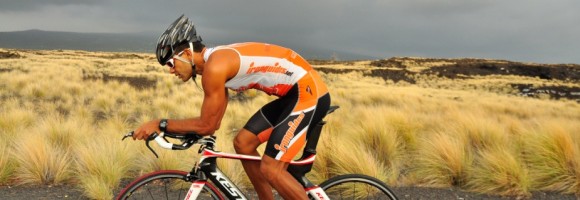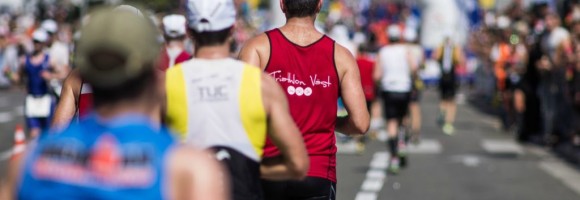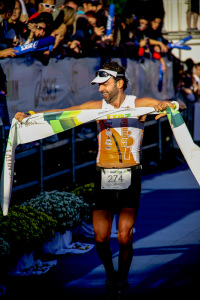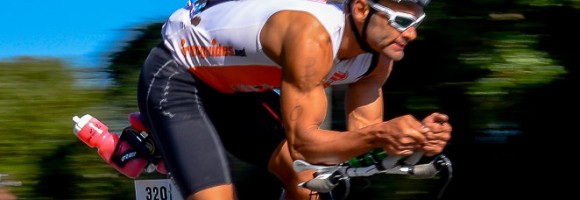With the Tour de France just behind us and the top cyclists back in the news, much of the cycling and triathlon media will have made plenty of comments about the higher cadence at which top cyclists rides. Unfortunately, nothing has compromised the average triathlete’s ability to improve on their bike more than the common assumption that maintaining a higher cadence equates to improved performances on the bike regardless of the rider’s ability and fitness. Not only do professional cyclists compete at far higher power outputs than the typical triathlete, but they also do not have to run at the end of the bike and can afford to push their legs and body much closer to the point of exhaustion by the end of the bike.
To better understand the importance of cycling cadence and effort in triathlon, you first need to understand how your bike cadence relates to competing in a triathlon as a whole, and how changes in cadence impact your body while you train or compete.
The easiest way to visualize cadence and its effect on your body is to picture the bike segment of a triathlon as an amount of “work” to be done, like a huge boulder sitting in your backyard that you need to move from Point A to Point B as quickly as possible. You can equate trying to move the boulder in one exhaustive effort with trying to complete the bike segment with one enormous pedal stroke using a huge chain ring like the one John Howard used setting the world land speed record on a bicycle. The work you need to do to move that boulder in one go or to pedal that bizarre contraption is going to take a huge amount of muscular exertion that will exhaust you by the time you get to Point B.
Your other option is to break up the boulder into a large number of small rocks that you carry from A to B – you’re on the right track here, unless you break up the boulder into so many pieces that you spend a lot of time hurrying back and forth, increasing your heart rate and putting a lot of aerobic stress on your body as you hurry as quickly as possible to move all those stones. This equates to using a very high cadence to move from A to B on the bike.
The ideal strategy lies somewhere in between: That is, breaking the work up into many manageable-sized pieces so that you can move as much of the boulder with each trip from A to B and can complete the work in as little time as possible. In other words, the right cycling cadence balances the stresses placed on your aerobic system by higher cadences, and the stresses placed on your muscles using a low cadence.
To understand this a bit better, you can picture the contraction your leg muscle makes with each pedal stroke as momentarily blocking the flow of blood into and out of the contracted muscle. A short contraction (high cadence) enables blood to flow into and from the muscle more often, which supplies nutrients and oxygen to the muscle and transports waste products and carbon dioxide away from the muscles more often – but at the expense of a greater stress on your aerobic and nervous systems. All those contractions force the heart to work harder and the nerves to fire more frequently. Conversely, a longer contraction (low cadence) blocks the transport of oxygen and nutrients into the muscle and traps breakdown products in the muscle for a longer period – that’s the “burn” you feel when you are riding with a slow, high contraction. However, your aerobic and nervous systems are not taxed as much.
The right cadence balances these stresses so that you can apply the greatest amount of force for the longest possible time. But contrary to what you might expect, “manageable” in the above context does not mean “relative to my fitness level.” Manageable means relative to the amount of work you are doing – in other words, the right cadence for you is relative to how much power you can produce on the bike, which depends by and large on your fitness and cycling-specific leg strength.
In other words, don’t compare yourself to what professional cyclists are doing – instead, look at what you are able to deliver on the bike. The stronger you are, the more forceful the contractions you can make on the bike. The fitter you are, the longer you will be able to make these contractions. And the greater the sustained force of the contractions you can make, the more you need to increase your cadence and “break the work up into more pieces.”
There’s one more piece to the puzzle, however. Unlike cyclists, as triathletes we also need to consider our approach to cycling in context of what comes next and keeping in mind that our goal is not to have the fastest bike split, it’s to have the fastest possible overall time at the finish. What you do on the bike in triathlon has to be understood in context of the demands you face on the run, too.
The reality of our sport is that we are always running on tired legs. That means that trying to run with a more forceful, longer stride rate in triathlon will quickly lead to disappointment because your tired legs have much less to give after the bike you’ve just done!
Instead, if you look at run speed as the product of stride length x stride rate, the most effective way to run faster in triathlon is to increase your stride rate (which can be learned), rather than trying for a forceful leg contraction. The price on your body for this faster rate of contraction is greater fatigue in your fast twitch muscle fibers.
A faster stride rate also means your motor neurons fire more frequently, which over time more quickly fatigues your motor neurons. This results in less forceful nerve signals, which in turn results in less forceful muscle contractions. But there’s ways to stave off this fatigue – recent research indicates that nervous system fatigue can be delayed by reducing the rate at which your nerves fire (Postactivation potentiation: Role in performance, British Journal of Sports Medicine: Volume 38(4) August 2004, pp 386- 387).
What does all this mean? In a nutshell, you need to ride your bike in a way that reduces the stresses that you will encounter on the run and keeps those systems as fresh as possible. The slow contractions of a slower cycling cadence (think of your legs as boa constrictors squeezing powerfully to drive the cranks around) will recruit fast twitch muscle fibers to a greater degree, which spares your slow twitch fibers for the run. And because a low cadence fires your motor neurons less frequently, you will reduce nervous system fatigue and enable fresher, stronger nerve signals on the run, resulting in stronger run muscle contractions than you might otherwise be able to generate after riding with a high cadence.
As well, because slow twitch fibers don’t contract as explosively and by definition not as often, you reduce the strain on your aerobic system. By riding with a lower aerobic intensity, you also burn less glycogen and can preserve this muscle fuel for the run. Your lower heart rate will also save some of your capacity for lactate tolerance for the run segment of the race.
Is it really this straight forward? Well – yes and no! “Yes” because by and large, triathletes need to factor in all of the above and should opt for a slower cadence between 75-85 pedal strokes per leg, per minute. As well, most age group triathletes do not have the aerobic conditioning or strength to generate the kind of power that requires higher cadence. By training at a low cadence against high resistance, however, you will quickly develop leg strength while reducing aerobic stresses in training – in effect, you tip the balance in your training from a more catabolic (a “breaking down” of the body) type of stress (aerobic system stress) to a more anabolic (a “building up” of the body) stress.
If you are new to triathlon or if you have bought into the “high cadence” approach to cycling for a long time, you’re giving up an opportunity to train strength and recruit more muscle with each of those puny little pedal strokes you’ve been taking! Try a few weeks of pushing a bigger gear, maintaining your speeds while reducing cadence into the low 80’s or lower – remember, you are training for your race, and that means applying effort in a way to improve performance with a goal in mind. Simply turning over the pedals at a slower cadence will not lead to improvements if you’re not forcing the muscles to work harder at the same time!
At the same time, I said “No” above because there are exceptions to the low cadence approach as your cycling abilities improve. As well, the shorter the distance at which you compete, the higher the power you are able to generate. If you are in the top echelons of performance in your age group you will need to increase your cadence for sprint, Olympic and even half
Ironman events.
Putting all this together at ironguides, we use some fairly simple tactics and tools to improve our athletes’ cycling splits in a triathlon-specific way. One of the sessions most of our athletes see on a regular basis is best done on a spin bike or computrainer, or a windtrainer you can rely on to generate very high amounts of resistance. After a thorough warm-up, complete anywhere from 10 to 30 efforts of the following:
60sec against heavy resistance
followed by
60sec zero-resistance easy recovery
We assign a cadence of 40 to 45 pedal strokes per leg per minute for this session, with a note explaining that the cadence should be this low because the resistance is so high that you could not possibly push any faster! For example, a 40-45 Age Grouper we coach pushes 20 of these efforts at 520 Watts – no wonder he’s been winning all of his sprint races this year and frequently placing top five!
You can create variations of this approach by pushing a massive gear out on the road, too, for longer intervals and aiming for that “boa constrictor” feeling, while staying in the aero position to simulate your race position as much as possible. Your consistent efforts to push hard against resistance will recruit more muscle and train your bike-specific strength quickly. With a properly structured training program, your all out, high-resistance efforts over varying durations will not over-stress your aerobic system while they consistently develop your leg strength.
It’s important to remember that a “properly structured training session” does not mean that you should use power goals to outline the session. Instead, each athlete completes his or her assigned sessions on a “best effort basis.”
You can use your power readings to provide feedback on how you are improving over time or to quickly spot fatigue and track improvement. But it is the structure of each session that generates the physiological changes we are after, whether these are high-resistance short intervals that do not overly fatigue your aerobic system while developing strength, or longer time trials done at the end of long rides that develop lactate tolerance.
Putting it all together, if you want to improve your overall triathlon times and your abilities as a triathlon cyclist, you need to adopt a lower cadence than you would use if you were training purely for cycling.
• If you’re a typical age group triathlete, avoid emulating cycling styles and approaches that are used by the top professionals, especially in cycling. We triathletes lack the combination of specific cycling strength and fitness to implement these approaches effectively.
• Remember that your cadence on the bike as a triathlete can be tailored to take into account what the run demands of you. A lower cadence than a cyclist would use for the same power output will contribute to fresher fast twitch muscles and less-fatigued motor neurons, helping you run faster.
• As a triathlete, you can’t ride to exhaustion. Using a larger gear and lower cadence reduces your heart rate and spares glycogen, while leaving capacity for you to run longer at threshold levels.
***
E.Y.T. – Enjoy Your Training!
ironguides is the leading Lifestyle Facilitation company for athletes of all abilities. We provide coaching and training services, plans and programs, as well training education, health and fitness products to help you learn and live a healthy lifestyle. Come get fit with one of our monthly training subscriptions, event-specific training plans, coaching services, or a triathlon training camp in an exotic location! ironguides also provides Corporate Health services including Corporate Triathlons, Healthy Living retreats and speaking engagements. At ironguides, your best is our business!
–
Train with ironguides!
Personalized Online Coaching: Starting at USD190/month
Monthly Training plans (for all levels, or focused on one discipline): Only USD39/months
Event based training plans:
Sprint Distance (USD45 for 8-week plan)
Olympic Distance (USD65 for 12 week plan)
Half Ironman (R$95 for 16-week plan)
Ironman (USD145 for 20-week plan)
X-Terra (USD65 for 12-week plan)
Running Plans (10k, 21k and 42k – starting at USD40)













Recent Comments